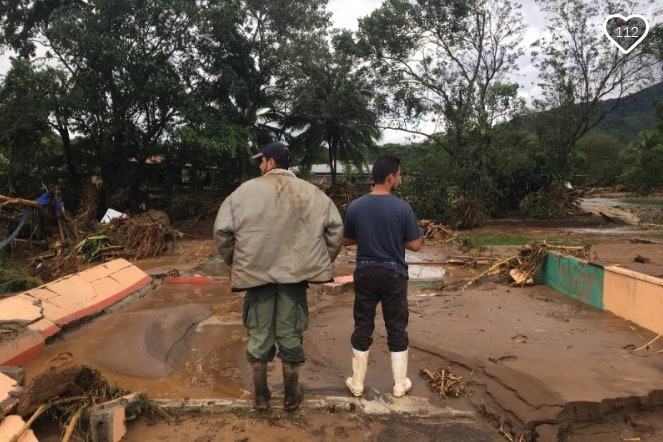BIJAGUA, Alajuela – As most people know by now, Hurricane Otto caused a path of devastation across northern Costa Rica late last week.
One of the hardest hit communities is the little town of Bijagua, part of the canton of Upala. Nestled in a valley between the Miravalles and Tenorio Volcanoes, there is a bit of tourism here – mostly visitors heading for the beautiful blue Río Celeste in the Tenorio Volcano National Park or enjoying the birding and wildlife of the area. But most of the economy is dependent on small farmers and small dairies.
The weather in Bijagua on Thursday was mild: a little wind and just a few showers off and on. People could hardly believe the dire warnings about what was to come. But come it did, later that night, and in the extreme darkness — no electricity, no street lights – it was horrific.
The biggest problem was water. The 24-hour rainfall was equal to a month’s normal rainfall. It flooded houses, fields and farms and caused an enormous wall of water and mud from a flash flood that took the lives of five Bijagua residents. Houses were destroyed completely and others washed away with only a partial foundation remaining.
But this is also a story of resilience and community: the men and women who went out time after time in the darkness of the hurricane on Thursday night to find and rescue whomever they could. One young man, concerned about his brother who lived next to a river, rode his motorbike in the dark storm to make sure his brother was OK. He ended up having to rescue the brother from his roof.
This is the story of a young boy who was stuck in a tree for hours, waiting for rescue and still in a state of shock.
This is the story of the older man who clambered onto his roof and called his son not for rescue but to say goodbye. “I will be with God,” he told his son. Thanks to wonderful neighbors, he was rescued.
This is the story of the little neighborhood “tienda” that had gotten a generator and so was open the next day when the two supermarkets were closed. The owner extended his hours and allowed people to charge their phones in the store.
There are several stories of people standing on furniture and holding onto the ceiling rafters as well as people on roofs, all in the darkness with gusty wind a deluge of rain.
There are many unsung heroes around. Neighbors went out and found people and rescued them. Bomberos? Police? No. Just your neighbor or your friend. Guys with trucks who rescued people and hauled them to safety and a dry place, time after time, putting themselves in jeopardy. Yes, the Costa Rican way.
Some people were warned to take shelter by a friend of mine who had been through hurricanes and insisted, insisted that one family go to a neighbor’s house that was two stories tall. They were stunned when they returned to their damaged house, but their lives were intact.
One tiny soda that was a project put together by a local women’s group was not swept away, but had about 4 feet of muddy water that destroyed everything inside. The soda still contains about 2 feet of mud.
A local tilapia farm was destroyed, as was the house and workshop of a guy who makes concrete statues, mostly of animals.
There are many people trying to help, including government agencies and organizations like the Red Cross or the local Development Association. But Bijagua has also taken in some refugees from the town of Upala, so there’s a lot to do!
One of the most heartening things is the reaction of people who have visited Bijagua. One local bed and breakfast, Casitas Tenorio, reports huge numbers of former clients asking, “What can we do?”
One small group has formed a committee to try and raise a significant amount of money to go directly to the 20 or so families totally displaced by Hurricane Otto. More than rice and beans and canned goods, their plan is to try and put these families’ lives back together by finding them each a house to rent, paying the first month’s rent and then providing a cash grant for the family to furnish the house and replace clothing, bedding and kitchen equipment. Each family will require a minimum of about $2,500 so the goal is high.
There are government and NGO projects to help these people, but all those take time. These families need help NOW. To help them, visit the crowdfunding page.
Really, it’s just another example of the wonderful Costa Rican spirit, and the special place that those folks known as “gringos” hold in their heart for Costa Rica.
See also: Here’s how you can donate to Hurricane Otto relief in Costa Rica







